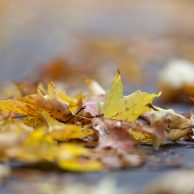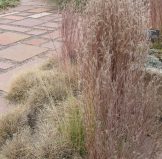
With this week’s unseasonably warm weather, there’s more time this fall to be out in the garden than usual.
DON’T BE TEMPTED TO CLEAN EVERTHING UP!
It’s important to leave many of those leaves and plants alone to support our insect, bird, animal and soils! It might be the most sustainable thing you can do this season.
A certain amount of garden clean-up is very important for reducing diseases and pests that are difficult to control. If you haven’t already done so, do remove diseased plants from your vegetable garden. You should have been removing and treating diseased foliage from roses or shrubs with fungal diseases like mildew, blackspot or rust before now, but if their disease-carrying foliage is falling now, keep them picked up and dispose of them responsibly.

But don’t be so quick to scalp those perennials and annuals! Many of them provide natural food and shelter sources that wildlife and beneficial insects depend on for winter survival. You may not have noticed, but so many beneficial insects and butterfly larvae spend the winter in the (often hollow) dead stems. If you throw them out, you’ll lose most of the beneficials that would otherwise keep the balance next year. Always keep an eye out for egg cases attached to stalks when you prune or clean up. There’s often an aesthetic side-benefit – many seed-heads look fabulous either crowned with snow or silhouetted against the snow-covered ground.
Some perennials die back to below ground (peonies, false indigo, gas plant, golden banner, balloon flower, desert four o’clock, gayfeather, leadwort/plumbago, etc.) leaving no basal growth and leaving a completely blank space. To make sure you don’t forget where they are and accidentally dig them up or step on them, leave dry stems until the new growth begins to appear in spring.
 Unless you have an ‘ornamental’ grass that self-sows aggressively, leave grasses and their seedheads standing. If they are ‘cool-season’ grasses, you’ll want to leave them until about mid-February, then cut them to 3” above the ground so they can begin making unimpeded new growth as soon as the soil thaws. Dormant ‘warm-season’ grasses can remain attractive until warm weather comes and don’t need to be cut down until April.
Unless you have an ‘ornamental’ grass that self-sows aggressively, leave grasses and their seedheads standing. If they are ‘cool-season’ grasses, you’ll want to leave them until about mid-February, then cut them to 3” above the ground so they can begin making unimpeded new growth as soon as the soil thaws. Dormant ‘warm-season’ grasses can remain attractive until warm weather comes and don’t need to be cut down until April.
Leaving dry stalks standing in the winter also helps preserve soil structure. Snow collects between the stalks and provides protection from freezing temperatures by insulation for the crowns of the plants, especially important for marginally hardy plants. Captured snow keeps soil temperature more consistent, protecting from extreme temperature fluctuations, and helps prevent the alternate freezing and thawing that can disrupt mycorrhizal networks (and uproot plants, especially new and small ones).

Leave the leaves! The larvae of many butterflies overwinter in the blanket of autumn leaves, as well as other beneficials. The leaves also provide cover for frogs, toads and spiders. Songbirds eat more than just seeds; they search in the leaf litter for insect eggs and caterpillars. As leaves naturally break down over time, they feed the soil microbes that make nutrients available to plants. Worried about harboring snail and slugs? Before those leaves begin to fall, spread a non-toxic slug bait like Sluggo in areas of concern. You may want to remove leaves and twigs from patios, decks, walkways and lawns, and that’s fine – especially if you can spread them under shrubs or pile them in a corner where they’ll remain undisturbed through the winter. And very large, flat leaves from trees like Catalpa, Basswood (Tilia americana), Norway Maple, Sycamore/London Planetree) should be cleared from beds or they can form a slick solid mat that smothers the crowns of smaller plants.
